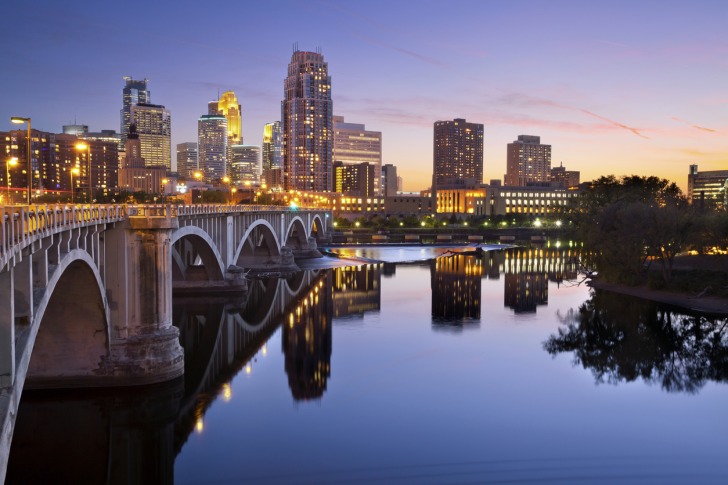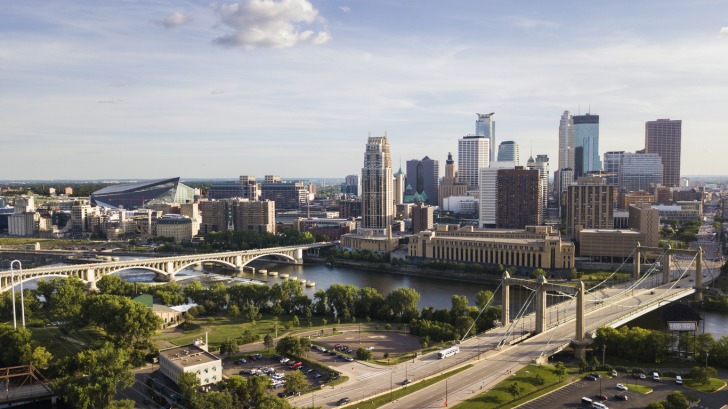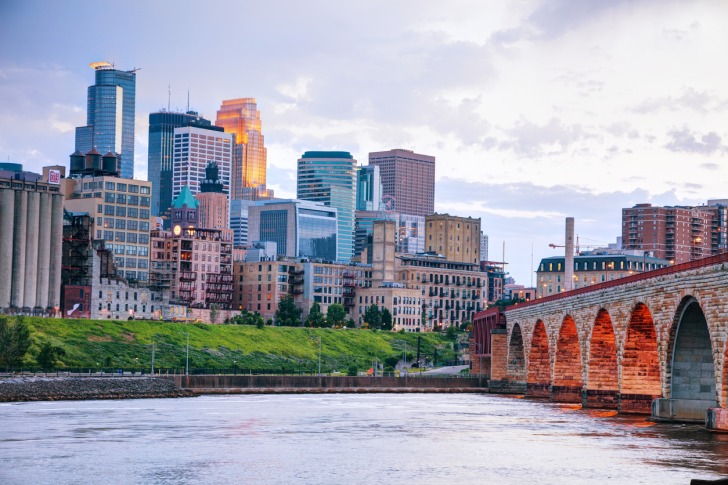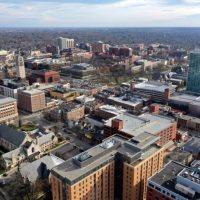When you think of Minneapolis, you may envision harsh and cold winters, which is true.
However, there’s also the progressive, artsy scene, many green spaces, and a growing city with a sustainability flair.
Minneapolis is a job-seekers haven with a robust, diverse, and bustling economy, centered by a tech industry that’s gripping attention across the U.S.
This means high-paying opportunities are continuously opening in a highly affordable city.
If you’re considering moving to Minneapolis, viewing both sides is important.
Keep reading to learn more about the pros and cons of living in Minneapolis!

Contents
Pros of Living in Minneapolis
Minneapolis offers a wealth of pros for living in the city, including the following:
1. Environmentally Friendly
One major per for living in Minneapolis is locals are incredibly environmentally conscious, so they take pride in the city and strive to reduce the carbon footprint.
As a result of this focus, the city is one of the greenest in the U.S., committed to offering residents green spaces, buying local produce, making the area bikeable and walkable, and reducing waste through recycling programs.
Also, Minneapolis is America’s 7th least wasteful city, supported by its environmental programs.
2. Excellent Quality of Life
One of the first realizations when moving to Minneapolis, especially from a larger city, is that life feels significantly less stressful.
This is because the city is consistently ranked as one of the best in the nation for quality of life.
In addition to having abundant jobs, the city boasts an affordable cost of living and exceptional culture.
Within the first week, it’s easy to see why locals live happier in the Twin Cities than in other major metropolitan areas.
3. Exceptional Biking City
Boasting over 98 miles of bike lanes, 101 miles of off-street bike trails, and 16 miles of protected bikeways, Minneapolis is one of the best biking cities in the U.S.
The Midtown Greenway and Grand Rounds Scenic Byway are two examples of efficient and scenic routes cyclists can enjoy.
Minneapolis also boasts The Nice Ride bike-sharing program, which offers easy access to bicycles for visitors and locals.
Surprisingly, the cold weather doesn’t slow cyclists since the city focuses on clearing snow in bike lanes and paths, often before the roads.
4. Good Job Opportunities
One of the best reasons to move to the city is the availability of jobs.
Boasting an unemployment rate of 3.3 percent, compared to the national average of 3.6 percent, Minneapolis boasts excellent economic stability, which continues to attract young professionals.
In addition to economic robustness, job diversity is plentiful, which ranges from healthcare and education to entertainment and tourism.
The biggest employers in the city include 3M, Best Buy, the Mayo Clinic, Target, and the United Health Group.
5. Low Cost of Living
Probably the biggest draw on this list to living in Minneapolis is the low cost of living, which helps maintain a high quality of life.
Residents can enjoy experiences, and it’s more because they can afford them.
Haircuts, groceries, entertainment, drinks with friends, and eating out occasionally won’t break the bank.
Jobs pay decent wages, so residents can afford to do more than simply pay bills and aren’t living paycheck to paycheck.
6. Manageable Sized City
Many residents report that one of their favorite aspects of Minneapolis is it’s the perfect size city.
It has plenty of big city amenities, like professional sports teams, world-class museums, and exceptional performance centers, but it doesn’t feel overwhelming.
With a population of 425,000, Minneapolis is a mid-size city that doesn’t have exceptionally high density or excessive urban sprawl, thus making it feel accessible.
The ample green spaces on every block also help to make it feel more open and less congested.
7. Park Accessible
One of the perks that many are surprised by is that Minneapolis has one of the best park systems in the U.S.
The government and community take green spaces so seriously that a whopping 96 percent live within only a 10-minute walk of a park or other green space.
Lake Harriet Park is an excellent place to spend a relaxing summer afternoon.
If you want a more natural experience, escape into the Mississippi River Gorge Regional Park.
When parks are within walking distance, the mood and local mentality change to a positive enjoyment.
8. Strong Craft Brew Scene
For those who love craft brews, you will love Minneapolis.
The city makes some of the best craft beers in the U.S.
With 38 breweries, Minneapolis boasts the 9th highest number of breweries per capita, so there are plenty of excellent locations to check out, especially for those who love IPAs.
While this is a minor consideration for uplifting your life, it adds to the cultural richness offered by Minneapolis.
Cons of Living in Minneapolis
On the other hand, it’s critical to understand the drawbacks to living in Minneapolis, which include the following:
1. Bad Traffic
As with all major cities, Minneapolis grapples with increased road congestion due to the city’s growth.
Commuters are stuck in traffic for long hours, thus leading to heightened stress levels and long travel times.
Although the city promotes alternative transportation, the vehicular burden remains problematic.
The excessive traffic during rush hour commuting then impacts the air quality for residents, which is especially problematic on hot and dry summer days.
2. Excessive Allergies
One of the greatest downsides to living in Minneapolis is the impact allergies can have on daily life.
Given its position in the Upper Midwest and green space abundance, the city can be incredibly challenging for allergy sufferers.
Fall and spring are particularly challenging due to high pollen counts from weeds, grasses, and trees.
In addition to the pollen, Minneapolis is a major city, so air quality due to smog is a major concern.
3. High Taxes
One major downside to living in Minneapolis is it has the 5th highest tax rate in the U.S.
However, this gets you the third most educated state in America, with a high quality of life emphasizing welfare, healthcare, and social programs.
Even though the taxes are high, they pay for programs that help the community.
This could be problematic depending on your viewpoint of where you want your tax money to be spent.
4. Infrastructure Issues
In addition to the traffic issues Minneapolis faces, the city is old and battles with aging infrastructure.
This includes utilities, public buildings, bridges, roads, and highways.
While efforts to upgrade the infrastructure continue, this equates to debates over funding priorities and construction disruptions.
If you come from a major city, the traffic and crumbling infrastructure may not be a surprise, but those from a small town may find this challenging.
5. Long Winters
One of Minneapolis’s most obvious drawbacks is the long winters.
This season tends to feel extra long because of the depressing grey skies and blistering cold temperatures.
In the middle of winter, highs of 0 for several consecutive days can be rough on your mental health.
The best medicine is to start engaging in winter sports and learn more about layering.
Another aspect of this long season is the sun rises late and sets early, so if you’re working regular business hours, you won’t see the sun unless you go outside during work.
6. Politics
Depending on your political stance, Minneapolis could be a pro or a con.
Ranked the 6th most liberal city in the U.S., you won’t align well with the city’s government if you fall into the right-wing category.
Many Minneapolis residents have strong political opinions, which can be refreshing if you’re a Democrat or annoying if you’re a Republican.
While this shouldn’t necessarily influence your move, it’s an important consideration that could impact your daily life.
7. Reserved Locals
Locals tend to be more reserved and closed off if you’re from out of town.
Therefore, if having a large friend circle is important, you must focus on befriending other transplants, or you will feel incredibly lonely when living in Minneapolis.
The best way to combat this is through common activities, which are plenty through apps like Meetup.
Join a kickball league or another team game to meet locals and other transplants.
8. Socio-Economic Disparities
Although Minneapolis has a reputation for cultural richness and a thriving economy, stark socio-economic disparities exist.
Specific neighborhoods have higher levels of unemployment and poverty, with limited essential amenity access.
These disparities are tied to ethnic and racial lines, creating tensions with communities, which has led to national infamy.
The city is working on bridging these gaps, leading to bigger discussions about accessible education, equal employment opportunities, and affordable housing.

Pros and Cons of Living in Minneapolis, MN – Summary Table
| Pros of Living in Minneapolis | Cons of Living in Minneapolis |
|---|---|
| 1. Environmentally Friendly | 1. Bad Traffic |
| 2. Excellent Quality of Life | 2. Excessive Allergies |
| 3. Exceptional Biking City | 3. High Taxes |
| 4. Good Job Opportunities | 4. Infrastructure Issues |
| 5. Low Cost of Living | 5. Long Winters |
| 6. Manageable Sized City | 6. Politics |
| 7. Park Accessible | 7. Reserved Locals |
| 8. Strong Craft Brew Scene | 8. Socio-Economic Disparities |
Minneapolis Safety Overview
READ THE FULL REPORT: Minneapolis Safety Review
Safety Index:
- OVERALL RISK: MEDIUM
- TRANSPORT & TAXIS RISK: LOW
- PICKPOCKETS RISK: LOW
- NATURAL DISASTERS RISK: MEDIUM
- MUGGING RISK: MEDIUM
- TERRORISM RISK: MEDIUM
- SCAMS RISK: LOW
- WOMEN TRAVELERS RISK: LOW
Frequently Asked Questions
Is Minneapolis a good place to live?
Minneapolis is ideal for those looking to blend an excellent recreational scene, vibrant arts, a strong job market, natural beauty, and urban amenities.
Those valuing a sense of community, outdoor activities, and sustainability while navigating colder climates and the challenges of urban living will find the city incredibly appealing.
What do I need to know before moving to Minneapolis?
Despite the sometimes brutal winter weather, Minneapolis is a stunning city with a strong job market and an eclectic mix of neighborhoods.
Minneapolis and St. Paul are more different than alike, but both are easy to get around without a car.
Best of all, Minneapolis is an affordable big city well-connected to the world.
Is Minneapolis a good place to retire?
For those who appreciate a balance of robust healthcare, green spaces, and cultural events, Minneapolis is an excellent place to retire.
However, retirees must be comfortable with colder winters and value active senior living facilities that combine urban amenities.
Many opt for places like Florida because of the year-round weather, so winters in Minneapolis can be tough on the body.
Is Minneapolis a healthy city?
Residents highly focus on physical activity, especially around the city’s many green spaces and bike paths.
Also, the state boasts a strong agricultural community that allows its residents to access fresh-grown vegetables and fruit at grocery stores, markets, and restaurants.
As a result of physical activity and healthy eating, Minnesota is ranked the third healthiest state in the U.S.
What is the coldest month in Minneapolis?
The coldest month is January, with an average nighttime temperature of 4.3 degrees.
This can be difficult to deal with if you are not used to the cold weather.












Minneapolis offers a unique blend of environmentally friendly and progressive culture, job opportunities, and affordability, but also faces challenges with traffic, allergies, high taxes, infrastructure issues, long winters, political tensions, reserved locals, and socio-economic disparities.